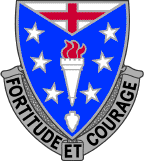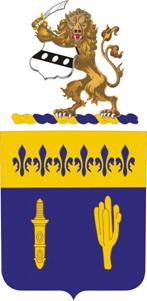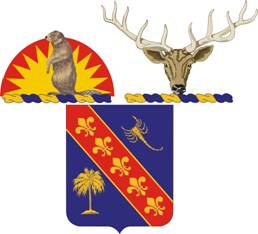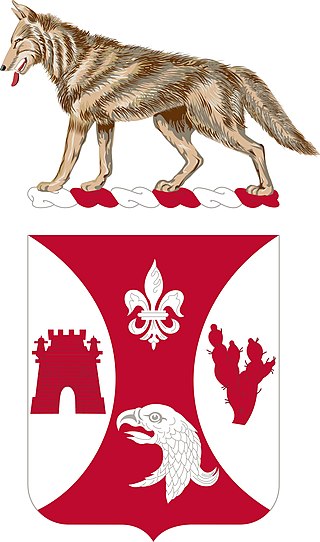The 198th Signal Battalion is an Expeditionary Signal Battalion in the Delaware Army National Guard. Delaware is known as the "First State," as referenced in their motto "First Regiment of First State." The unit specializes in command post node communications, providing broadband satellite voice and data connections for brigade sized battlefield elements. The unit includes Headquarters, Headquarters Company located in Wilmington, DE; A Company in Georgetown, DE; B Company in Hodges, SC; and C Company in Wilmington, DE. It is one of several National Guard units with colonial roots and campaign credit for the War of 1812.

The 213th Regional Support Group is a unit of the Pennsylvania Army National Guard. The 213th RSG mission is to provide command and control of the twenty-two separate Pennsylvania Army National Guard units assigned to the headquarters for operational and administrative control. This force consist of more than 1,000 soldiers from the eastern and central parts of the state. The 213th RSG is one of the two major commands in the Pennsylvania Army National Guard, the other being the 28th Infantry Division (Keystone).

The 104th Infantry Regiment traces its history to 14 November 1639, when it was first mustered as the Springfield Train Band in Springfield, Massachusetts. In 1662 the unit was formed into the Hampshire Regiment of the Massachusetts Militia. It later served in the Continental Army during the American Revolution, with Union forces in the American Civil War, and as a federalized Massachusetts National Guard regiment with the U.S. Army during Spanish–American War, Mexican Border Campaign, World War I and World War II. The last active element of the regiment, the 1st Battalion, was deactivated in 2005 and the soldiers and lineage transferred to the 1st Battalion, 181st Infantry Regiment.

The 112th Infantry Regiment, also known as the Sixteenth Pennsylvania, is a unit in the Pennsylvania National Guard which can trace its lineage back to before the American Civil War.
The 102nd Field Artillery Regiment is an inactive Field Artillery Regiment in the Massachusetts Army National Guard. Originally organized in 1786, the 102nd Field Artillery's predecessor units served in the Civil War, the Spanish–American War, and World War I. Units of the regiment served with the 26th Infantry Division during World War II and the Cold War.
The 150th Field Artillery Regiment is a field artillery unit in the Indiana Army National Guard.

The 109th Infantry Regiment is a parent infantry regiment of the United States Army, represented in the Pennsylvania Army National Guard by the 1st Battalion, 109th Infantry, part of the 2nd Brigade Combat Team, 28th Infantry Division.

The 111th Infantry Regiment, was originally the Pennsylvania Militia or "Associators" that fought in the American Revolution, composed of civilian males from the citizenry of Pennsylvania. It is one of several National Guard units with colonial roots and campaign credit for the War of 1812. The Pennsylvania Militia often fought in conjunction with General Washington and the Continental Army along the Delaware River. Today the idea of a Pennsylvania Militia is represented in the U.S. Army by 1st Battalion, 111th Infantry assigned to the Pennsylvania Army National Guard's 56th Stryker Brigade Combat Team, 28th Infantry Division. The regiment, founded as the Associators by Benjamin Franklin in Philadelphia, Pennsylvania on 21 November 1747, is the oldest regiment in Pennsylvania.

The 56th Stryker Brigade Combat Team (SBCT), 28th Infantry Division, also known as the Independence Brigade, is a brigade combat team of the Pennsylvania Army National Guard and has its headquarters located at Horsham Air Guard Station in Willow Grove, Pennsylvania.

The 300th Field Artillery Regiment is a Field Artillery regiment of the United States Army.

The 146th Field Artillery Regiment is a field artillery regiment of the Army National Guard first Constituted in 1886 as the 1st, and 2nd Regiments of Infantry.

The 148th Field Artillery Regiment is a Field Artillery Branch regiment of the Army National Guard.

The 168th Field Artillery Regiment was a Field Artillery Branch regiment of the Army National Guard.
The 137th Field Artillery Battalion is a field artillery battalion of the Army National Guard.
The 213th Air Defense Artillery is a regiment in the Pennsylvania Army National Guard.

The 196th Infantry Regiment is an infantry regiment of the United States Army National Guard. It traces its lineage to units which have been both infantry and engineers.

The 55th Maneuver Enhancement Brigade is a maneuver enhancement unit aligned under the 28th Infantry Division of the Pennsylvania Army National Guard. The 55th MEB, like all MEBs, is a self-contained, modular, and multifunctional support brigade of the United States Army with an ability to plug into operational formations commanded by corps or division commanders, to support brigade combat teams once deployed, and to conduct tactical level tasks and support. MEBs are equipped to provide command and control for up to seven battalions that are capable of owning battlespace in combat. The 55th MEB was once the 55th Heavy Brigade Combat Team "strike brigade" subordinate to the 28th ID, as the 55th MEB is today. Its headquarters is in Scranton, PA.

The 107th Field Artillery Regiment is a Field Artillery Branch regiment of the United States Army. It has been affiliated with the Pennsylvania National Guard since its formation. It appears that the regiment last formally came into existence in June 1959, when the 107th Field Artillery Battalion was reorganized as the new Regiment's 1st Battalion in line with the Pentomic (ROCID) reorganization going on at that time.
The 120th Field Artillery Regiment is a field artillery regiment of the Wisconsin Army National Guard.

The 142nd Field Artillery Brigade is a field artillery brigade in the Arkansas Army National Guard (ARNG). The 142nd is currently under administrative control of the 29th Infantry Division.














